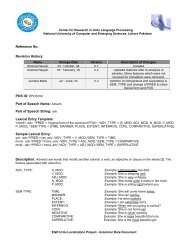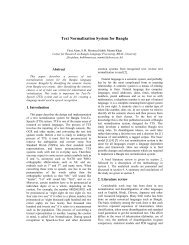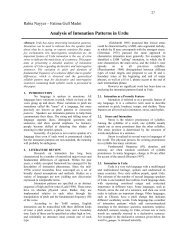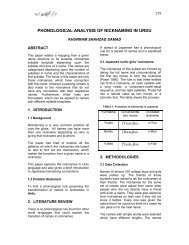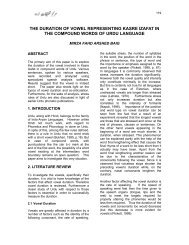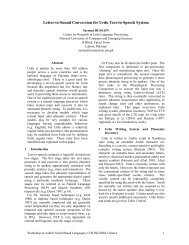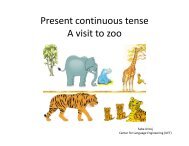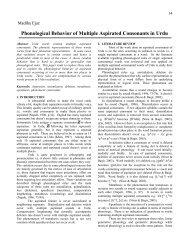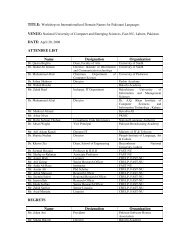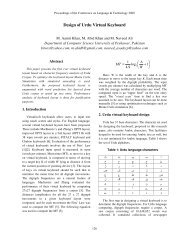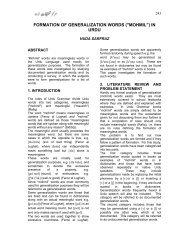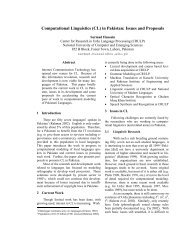Corpus Based Urdu Lexicon Development
Corpus Based Urdu Lexicon Development
Corpus Based Urdu Lexicon Development
Create successful ePaper yourself
Turn your PDF publications into a flip-book with our unique Google optimized e-Paper software.
one standard character (depending on their<br />
position within the word) in order to normalize<br />
them before any processing was done on them.<br />
• Diacritics were removed from the word list e.g.<br />
/t̪ir/ (arrow) were both تِير /t̪ær/ (swim) and تَير<br />
.تير mapped to<br />
• Word frequencies were updated.<br />
• The tokenization based on space does not<br />
completely identify the words from the corpus<br />
correctly. The output needs to be reviewed in<br />
order to remove non-words which may occur<br />
due to erroneous output of tokenizer or due to<br />
typing errors. Proper names, typos etc were<br />
removed from the word list manually and the<br />
words that were written without space were<br />
separated (space insertion problem) e.g. the<br />
طاہر words, comprises of four طاہرکوکهلاد يا token<br />
/t̪a.h ɪ r/ (proper name and an adjective), کو /ko/<br />
(case marker), کهلا / kʰ ɪ .la/ (verb) and ديا / d̪ ɪ<br />
.ja/ (verb). Word frequencies were updated<br />
after space insertion.<br />
When non-words were analyzed, it was revealed that<br />
most of them were affixes apart from proper names and<br />
typos. Hence a list of valid <strong>Urdu</strong> affixes was developed<br />
and tokenizer was modified to pick next or previous<br />
word if it encountered a prefix or suffix respectively and<br />
”ذمہ داری“ e.g. frequencies were adjusted accordingly<br />
/zɪm.mɑ.d̪ɑ.ri/ (noun: “responsibility”) is a word with<br />
affix "داری" if its frequency was 10 then 10 was<br />
subtracted from the frequency of " "ذمہ and from the<br />
frequency of داری" " as well.<br />
4. <strong>Urdu</strong> <strong>Lexicon</strong> <strong>Development</strong><br />
<strong>Urdu</strong> lexicon development involved decisions<br />
regarding part-of-speech tags and their respective<br />
features, lemmas, transcription and lexicon format.<br />
4.1. POS tags<br />
Since the lexicon is to be used for speech-to-speech<br />
translation components, a high-level POS tag set<br />
covering main categories is adequate.<br />
POS tags decided for <strong>Urdu</strong> lexicon development are<br />
as follow<br />
1. Noun.<br />
2. Verb.<br />
3. Adjective.<br />
4. Adverb.<br />
5. Numerals.<br />
6. Post positions.<br />
7. Conjunctions.<br />
8. Pronouns<br />
9. Auxiliaries.<br />
10. Case marker.<br />
11. Harf.<br />
All the recognizable POS tags of the word were<br />
identified, regardless of the context in which the word is<br />
used in the corpus. The details of the POS tags are given<br />
in Appendix B.<br />
Two of the above listed POS are particular to <strong>Urdu</strong>.<br />
Their details are given below:<br />
4.1.1 Harf: Harf is a word which is not meaningful<br />
unless used with other words to give meaning [10]. This<br />
واہ ho/, /o اوہو /æ/, ےا category includes words like<br />
/vɑ/, پر /pər/ etc.<br />
4.1.2 Case markers: Case markers are a special word<br />
class in <strong>Urdu</strong>. In some languages case marking is a<br />
morphological process, but in <strong>Urdu</strong> case markers are<br />
written with a space. Therefore they are considered as a<br />
separate word and are assigned a separate POS tag.<br />
There are mainly three case markers: ergative, نے /ne/,<br />
dative/accusative, کو /ko/ and genitive, کا /ka/.<br />
Sometimes سے /se/ is also included in this category as<br />
being an instrumentative case marker. Some<br />
grammarians [10] consider case markers as a subset of<br />
Haroof 1 , but due to their distinct role of case marking<br />
(agent/patient role etc), it is better to separate them from<br />
other Haroof.<br />
<strong>Urdu</strong> lexicon does not include respect feature. It also<br />
does not include separate POS tag for the light verb and<br />
aspectual auxiliary because both light verbs and<br />
aspectual auxiliaries have the same surface forms as a<br />
verb in the language. Once the wordlists are prepared<br />
from the corpus the context of the word is lost. In order<br />
to identify a word as a light verb or aspectual auxiliary it<br />
is essential to know whether it occurred in the corpus in<br />
combination with some other word or as an independent<br />
verb.<br />
4.2. Lemmas<br />
Lemma is a canonical form of a word. Morphological<br />
forms considered as lemma according to well-known<br />
guidelines of <strong>Urdu</strong> are the following:<br />
1. Common noun: singular, nominative with no<br />
respect<br />
1 Plural of Harf<br />
4


